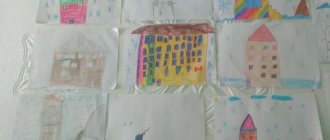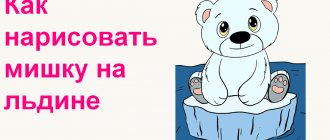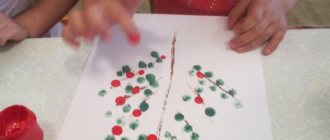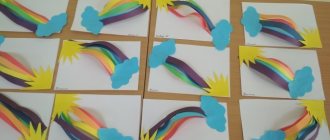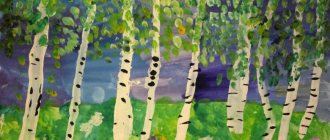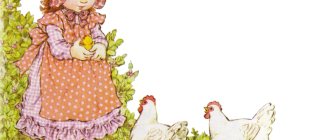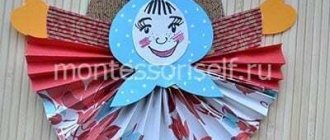Drawing lesson in the middle group on the theme of Spring
How to draw a spring landscape
Master class on drawing using unconventional techniques, drawing with paper balls: “Spring landscape”
If you see in a painting a river, or a spruce and white frost, or a garden and clouds, or a snowy plain, or a field and a hut, the painting is sure to be called a landscape.
The master class is addressed to educators and parents and is recommended for working with children 4-5 years old.
Goal: to familiarize children with non-traditional drawing techniques, drawing with paper lumps. Objectives: to introduce children to a new visual material - gouache, to consolidate the concept of landscape composition, to develop the ability to combine drawing techniques in the execution of work, to consolidate knowledge and skills in drawing from memory and by imagining naked trees, to find a simple composition, achieving linear expressiveness in working with new material, develop creative activity, the desire to draw, create, cultivate a love for native nature, develop the articulatory apparatus and fine motor skills of the hands. We will draw a spring landscape. “All the snowstorms have died down, And the frosts don’t crackle. — Drops dripped from the roofs, — And icicles hung in a row. - More fun and warmer - Our days with you have become. - In our garden in the alleys - The thawed patches are already visible. - A tit is shading loudly - Near our window... - Soon there will be a knock on our door - Real spring! 1. Materials for work: sheet A3 or A4, paper lumps, 2 strips of cardboard, 2-3 cotton swabs, hand napkin, 2 plates for clean and used lumps, diluted gouache (blue, cyan, yellow, pink, brown. Gouache black, white, green can be supplied in jars.
Finger gymnastics will help you make paper balls with your children. We squeeze a sheet of paper And unclench our palms We try to roll it Together into a ball We won’t let him get bored We’ll draw with it. 2. Take a paper ball and dip it with blue gouache, draw the upper border of the sky, blotting the sheet.
3. Apply blue color to another lump and blot the entire sheet.
4. Dip the next lump in pink and draw a beautiful pink dawn.
So we have drawn the background of the picture, now we need to let it dry a little, we can have a physical session with the guys. If a blue river Awoke from sleep (Hands up, stretched out to the sides.) And runs through the fields, sparkling, (Jumping on the spot.) That means spring has come to us. (Clap your hands.) If the snow has melted everywhere, And the grass in the forest is visible, (Squats.) And a flock of birds sings - That means spring has come to us. (Clap your hands.) If the sun turns our cheeks red, (Tilts the head to the left and right shoulders.) It will become even more pleasant for us - That means spring has come to us. (Clap your hands.) 5. Now cardboard strips will help us in our work; apply brown color to the strip and draw a tree trunk by touching it to the leaf.
6. Using the edge of a cardboard strip, draw tree branches.
7. Apply white gouache to a cotton swab and draw flowers on the tree branches.
8. Dip the tip of another cotton swab into green gouache and draw green leaves.
9. Using a clean cardboard strip, draw thawed patches near the tree.
10. We dip the paper ball in yellow and in the corner of the picture the rising sun shines, its rays spread across the clearing.
11. My children also drew flowers on the thawed patches.
This is a simple but very interesting technique that children really like. I wish you creative success, friends!
We recommend watching:
Unconventional drawing technique pointillism
Drawing using the Blotography technique in the middle group of kindergarten. Non-traditional drawing. Middle group Drawing lesson in kindergarten on March 8
Similar articles:
Fine arts lesson for the senior group
Monotype in kindergarten
Non-traditional drawing techniques in preschool educational institutions
Non-traditional drawing technique in kindergarten. Passepartout
Wax painting in kindergarten
All-Russian interactive educational portal "Axioma"
performed:
teacher
Zhekhovskaya Anastasia Yurievna
MBDOU "Kindergarten No. 13", Ussuriysk
Abstract of GCD in the middle drawing group “Spring is Red” (Non-traditional visual technique) Priority educational area: “artistic and aesthetic development” Integration of educational areas: “artistic and aesthetic development”, “social and communicative development” Goal: improving aesthetic perception and creative abilities. Objectives: 1. To consolidate the idea of spring. 2. Continue to teach children to use non-traditional drawing methods in their works (drawing with a poke, crumpled paper) 3. Continue to develop the ability to create plot compositions, repeating images of the same objects (trees), adding others to them (clouds, birds) 4. Develop visual attention and imagination. 5. Foster an aesthetic attitude towards spring nature. Preliminary work: • Examination of paintings depicting spring; • Observation of trees and flowers in the kindergarten area; • Acquaintance with various non-traditional drawing methods; • Reading poems about spring; Methods and techniques: Verbal, visual, practical. Materials and equipment: For the teacher: audio recording of the sounds of the forest, paintings depicting spring; For children: album sheets, napkins, saucers with blue, yellow, brown paint, cotton swabs, sheets of paper, a saucer for used paper.
Progress of organized activities: - Guys, I invite you on a trip to a magical land, to visit Spring, to admire the blooming flowers and green trees. - Let’s imagine that we find ourselves in a spring meadow, but something happened, where are the trees, where are the flowers? Look, it seems there is only one flower left. (The teacher picks up the flower and reads the message on the back) - “I am the last flower, all the trees and flowers were bewitched by the evil Slush and they became invisible, and she hid Spring in her palace. Help!" -Guys, what should we do, how can we help Spring? -Let's make riddles with you! 1. Loose snow melts in the sun, The breeze plays in the branches, Birds’ voices are louder, This means that it has come to us... (Spring) 2. Streams run faster, The sun shines warmer. The sparrow is happy about the weather - A month came to visit us... (March) (Children's answers) -What can you see in the forest in the spring? (The buds on the trees swell, young leaves appear, the grass turns green, birds fly in, flowers bloom) - Guys, now I propose to become wizards and draw a spring forest. Let's close our eyes and begin the transformation: One, two, three, magic happens! -Go to the tables. — First we will draw a tree. (I accompany the explanation with a demonstration) - But there are no leaves on it yet, only buds, we will draw them with a cotton swab and a poke. - What will we see in the sky? (Clouds, clouds) - Let's draw the clouds with compressed lumps of paper. Take the paper, crumple it so that you get a paper ball, dip it in the paint and apply it to the sheet. (Children do the work) - Now let’s finish drawing the grass in the same way. We crumple the paper, what color should we take now? (Green) - What is missing from our landscape? (Sunny) - Now we’ll turn into flowers for a minute. Physical - minute “Butterfly” The flower was sleeping and suddenly woke up, (torso to the right, left.) Didn’t want to sleep anymore, (torso forward, backward.) He moved, stretched, (arms up, stretch.) Soared up and flew, (arms up , right, left.) The sun just wakes up in the morning, the butterfly is spinning and curling. (spin around) (Children take their seats) - Now you and I will continue our landscape and draw the sun (Turn on the audio recording “Sounds of the Forest”) You and I are real wizards, can you hear how the forest talks? This means that we managed to drive away the evil Slush and help Spring. She returned to us.
Go to publications for teachers Media Axiom
On the topic: methodological developments, presentations and notes
The teacher should strive to develop interest in the work of Mordovian artists through familiarization with the paintings of F.V. Sychkov. Form the idea that the Mordovian people are dying of their outstanding ones.
The teacher introduces children to the work of Mordovian artists through familiarization with the paintings of F.V. Sychkov.
Introducing children to paintings by Russian painters, listening to musical works and artistic activities.
Lesson summary on modeling (plasticine) Topic: “Spring landscape” (Senior group).
Goal: development of children's creative abilities. Objectives: 1. To consolidate and clarify children's knowledge about spring and its characteristic features.2. Behind.
Source
Summary of GCD in the middle group using non-traditional drawing techniques “Spring Landscape”
Goal: to teach children to notice changes in nature with the arrival of spring, to convey in the drawing the characteristic features of spring nature; cultivate interest and respect for nature.
Spring landscape abstract of continuous educational drawing activities
Department of Education of Volgograd Administration
Krasnoarmeysk Territorial Directorate of the Education Department of the Volgograd Administration
Municipal educational institution Kindergarten No. 2
municipal preschool educational institution
"Kindergarten No. 2 of the Krasnoarmeysky district of Volgograd"
Address: 400082, Russia, Volgograd, Tel/, 62-38-98
SPRING LANDSCAPE
summary of continuous educational activities in drawing
Compiled by:
teacher
highest qualification category
Volgograd 2016
Summary of continuous educational activities in drawing
Subject:
"Spring Landscape"
Educational area:
Artistic and aesthetic development
Integration of educational areas
: Social and communicative development, cognitive development, physical development, speech development.
Children's age
: 5-6 years
GCD form:
productive, workshop for the production of children's creativity products.
Form of organization of NOD
: subgroup work (10 children)
Target:
Creating conditions for developing skills in landscape drawing using non-traditional image acquisition techniques.
Tasks
:
Educational
:
· Introduce children to various methods of obtaining images.
· To introduce children to the genre of fine art “Landscape” and its distinctive features.
· To develop drawing skills by combining visual means (using the “Magic Drawing” technique)
Developmental
:
· Develop fine motor skills and graphic skills.
· Develop a sense of composition and color perception (selection of the color scheme of a drawing).
· Develop logical thinking, drawing in a single storyline.
Educational:
· Cultivate interest in productive activities.
· Cultivate a sense of purpose and a desire to complete what has been started.
· Cultivate accuracy when working with watercolors.
Dictionary of new words
: scenery.
Equipment and materials
: multimedia projector; easels: 10 pcs – for children’s work, 4 pcs. – for demonstration samples of landscapes; demonstration samples of landscapes (4 pieces), made using the technique “On a wet sheet”, “Plasticineography”, “Bitmap”, “Magic drawing”; artist's clothing set (cape, beret, scarf): 10 pcs. – for children, 1 pc. - for the teacher; colored wax crayons - 11 packs, sheets of paper for watercolor A4 size - 11 pcs.; brushes No. 5 – 11 pcs.; palette with diluted watercolor paint for filling the background – 11 pcs.; jars of water – 11 pcs.; fabric napkins – 11 pcs.; frames for children's work attached to the back of children's easels - 10 pcs.; doll – bibabo “Cheerful Pencil”; electronic presentation – accompaniment of the lesson; interactive game "Landscape".
Progress:
1. Organizational moment.
Educator
: Guys, today I didn’t come to your lesson alone, let me introduce you to my friend Cheerful Pencil.
2. Motivation for activity
(The teacher turns on the multimedia screen and a Fun Pencil appears on it
)
Cheerful pencil
: Hello, my little drawing lovers! I want to invite you to my art gallery. The gallery exhibits the most beautiful landscapes. Do you know what a landscape is?
Children:
No. (YES - I invite the children to formulate an answer).
Cheerful pencil
: Landscape is a picture that depicts nature: forest, rivers, seas, houses, mountains. Guys, go to the gallery, look at the landscapes that were painted by my little artist friends.
(The “Art Gallery” screensaver appears on the multimedia screen, the teacher invites the children to look at the exhibition of landscapes
)
Educator
: (
brings the children to the first landscape, made using the “Drawing on Wet Paper” technique
) Guys, this landscape was made using the method of drawing on a wet sheet of paper. The image appears unclear, as if blurred.
(The teacher leads the children to the second landscape, made using the “Plasticineography” technique)
Educator
: And this landscape is made using plasticine. The image of details is bright and clear.
(The teacher leads the children to the third landscape, made using the “Bitmap” technique
)
Educator
: And this landscape is made using dots made with a variety of objects - cotton swabs, pokes, fingers.
(The teacher leads the children to the fourth landscape)
Educator:
And this landscape was painted using the “Magic Drawing” technique. Guys, what time of year is it depicted?
Children
: Spring.
Educator
: Why do you think so?
Children
: Here is a picture of a tree with small leaves. The first spring flowers, snowdrops, are depicted here. A flowering tree is drawn here.
Educator
: Yes, guys, this landscape depicts spring.
Educator
: Guys, what unites all these pictures? How are they similar?
Children
: They depict nature.
Educator
: Guys, do you remember the name of the picture that depicts nature?
Children
: Scenery.
Educator
: Yes, guys, this picture is called a landscape.
(The Jolly Pencil appears on the multimedia screen
)
Cheerful pencil
: Well, my young artists, have you looked at the landscapes in my gallery? I suggest you play the Landscape game and better remember what is depicted in the landscape.
Game: "Landscape"
(On the multimedia screen there is a picture frame with a filled-in background. Around her are objects that may belong to the “Landscape” genre and objects that do not belong to the named genre. The teacher invites the children to name only those objects that belong to the “Landscape” genre. If the child names the object correctly, it moves onto the canvas of the picture. If the child makes a mistake, a signal sounds and the picture does not move. Thus, after naming all the objects related to the landscape, a landscape painting appears in the frame.)
(After the game, a Cheerful Pencil0 appears on the screen
Cheerful pencil
: Guys, you coped with this task very well, and now you know what can be depicted in a landscape. And today I invite you to draw your own spring landscape. Do you agree?
Children
: We agree.
3.Dynamic pause
Educator
: Then I invite you to our creative workshop. But before you start drawing, you need to prepare your fingers for work.
(finger gymnastics is performed
)
Finger gymnastics:
| So we took the paints in our hands | Squeeze and unclench your palms |
| And there was no boredom in the house! | |
| To make it more fun | Clasp your hands and perform rotational movements. |
| Don't skimp on bright paint! | |
| Yellow, red, white, blue, | At each beat, connect the thumb with the other fingers, starting with the little finger |
| It turns out to be a picture! | |
| Well, what if we get bored | Shake your hands |
| Let's start drawing from the beginning! | Rub your hands palms together. |
4.Organization of productive activities:
(The Jolly Pencil appears on the multimedia screen
)
Fun pencil:
In order to start drawing, I suggest you become real artists. To do this, go to the easels and put on a cape, beret and scarf.
(The teacher helps
d
children take their places at the easels and put on the attributes of an artist
)
Educator
: Guys, today we will learn how to draw a spring landscape using the “Magic Drawing” technique. In front of you are sheets of paper, wax crayons and watercolors. Let's remember what was depicted in the spring landscape?
Children:
Sun, trees, clearing, flowers, clouds.
Educator:
Use wax crayons to draw the details of the landscape.
( Music of nature sounds.
The teacher performs a sample action
.
Children draw details of the landscape with wax crayons
)
Educator
: And now it’s time for the “magic”. Use watercolor paints to paint the background of your landscape. You can draw directly on the wax drawing. This is how the “Magic Drawing” turns out.
(The teacher shows a sample action
,
children fill the landscape background
)
Educator
: Guys, what wonderful landscapes you created!
( The teacher moves picture frames, pre-attached with ribbon, from the back of each easel
). It turned out to be a real art gallery!
5. Reflection.
(From behind the easel, a bibabo doll “Cheerful Pencil” appears on the teacher’s hand)
Cheerful pencil
: (
Looking at the children’s work
) What wonderful landscapes you have created! Guys, did you like drawing? Whose drawing did you like the most? What did you like about your drawing?
Children
: Magic drawing, draw with wax crayons, paint over the background with watercolors, etc.
Cheerful pencil
: Your landscapes can brighten up a group room. And you guys can now teach your friends to draw landscapes in this magical way.
Educator: Guys, I really liked how you worked today. Well, our lesson is over. Goodbye, guys! Present????
Literature and Internet resources used:
1. Vygotsky and creativity in childhood.-M., 1991.
2. Grigoriev preschooler in visual arts.-M., 2000.
3. Grigoriev’s techniques in teaching preschoolers visual arts. - M., 1995.
4. Kazakova with preschoolers in visual arts. – M., 1996
5. Komarov’s activities in kindergarten: learning and creativity. – M., 1990
6. Methods of teaching visual arts and design / Ed. . – M., 1991
7. "From birth to school." Approximate general educational program for preschool education / ed. , ,
8. ,Komarov activity in kindergarten. – M., 1982
9. Theory and methodology of visual activity in kindergarten / Edited by V. B. Kosminskaya. – M., 1997
Get text
On the topic: methodological developments, presentations and notes
Tasks1. Introduce a new technique of unconventional drawing - foam poking;2. learn to select and mix colors together to obtain.
Autumn, with a long thin brush, repaints the leaves red, yellow, gold. How beautiful you are as a colorful leaf. Autumn is a great time to collect colorful leaves. During the lesson, the children learned to create using l.
Drawing “Autumn Landscape” using the non-traditional painting technique “leaf imprint”. A very simple and interesting activity. The presentation used is “Autumn Opening Day”.
Source
